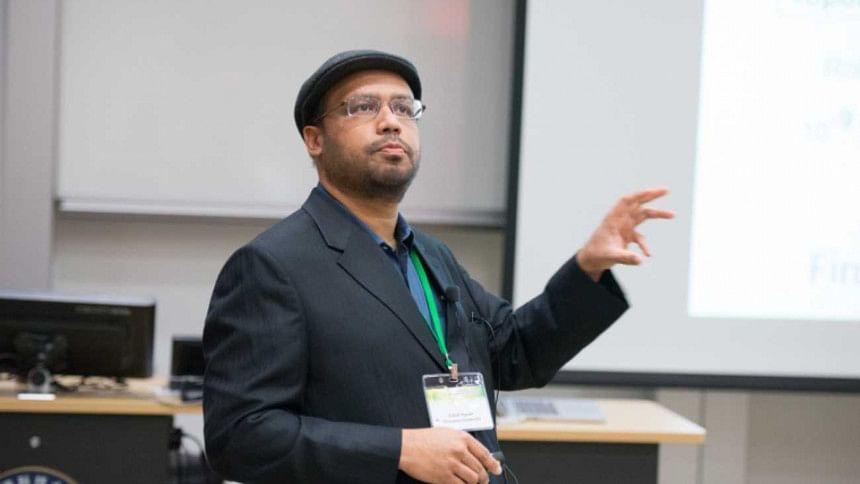Zahid Hasan

In 1929, German mathematician and theoretical physicist Hermann Weyl predicted the existence of a massless quasiparticle that kept physicists puzzled for 86 years. In 2015, a Bangladeshi physicist named Zahid Hasan, a professor of Princeton University, with his team of researchers discovered the elusive massless Weyl fermions particles that act like matter or anti-matter. After Satyendra Nath Bose, whose name has been immortalised by the invention of Bose-Einstein Condensate, Professor Hasan's achievement can be termed as the most significant contribution by a Bangladeshi in the world of physics.
Brought up in Dhaka's Dhanmondi neighbourhood, Hasan completed his higher secondary education at Dhaka College. He then got admitted to Dhaka University's (DU) physics department. However, before enrolling at DU, he got a scholarship to study physics in University of Texas at Austin. Later, Hasan completed his master's and doctorate degrees at Stanford University in California. In 2002, Hasan was offered a faculty position at the Princeton University where legendary physicist Albert Einstein was also a researcher in the 1930s.

It is Hasan's philosophy towards life and his insatiable urge to know the nature of truth that enabled him to work in some of the most reputed knowledge centres of the world. Professor Hasan says, "I tend to question nature, whether what we know is the absolute truth. If you look at the Gaussian distribution for biodiversity, it is evident that there are some people who are born with less than five senses and there are probably some people who are born with more than five senses. To them, the world is a different place and their definition of truth is different from what we perceive with our regular senses."
"I chose the path of science because it gives me the opportunity to explore the nature of truth in a quantitative manner which is more visible and easier to understand," he adds.
However, Hasan's endeavour to analyse the nature of truth led him to ponder over other, perhaps more complex, questions which influenced him to explore the world of particles. He began to wonder: "What is the origin of life and what is its destiny?" Hasan explains, "The human body is actually a collection of trillions of particles. Let's assume, we write down all the equations of all the particles and we solve the equations. The solutions to the equations certainly exist; otherwise you or I would not exist. So, by the principle of physics, we can find the origin, evolutionary process and the destiny of one's life just as if we know the position, direction and velocity of a car we can find out where it started travelling from and can predict where it will be after three hours. And, we also know that all particles are actually indestructible, they only transform or transition from one stage to another. So, you would think you will live forever in a sense."
"The most mysterious thing in this framework of thinking however is death. The equations of all the particles and their solutions remain more or less the same when you are dead yet there is a dramatic difference between life and death. These equations of the particles say that you exist but at the same time we are seeing that you as a conscious person actually don't exist in this world. So, where have you gone and what is that destiny?" questions Hasan.
Hasan has been devoting some of his time to research and find an answer to this philosophical question. Maybe his new research on biodiversity will shed light to the existence and origin of consciousness delineating the difference between life and death.
His unique way of questioning the existing truth and his exceptional style of exploring knowledge frontiers made him one of the most successful teacher-mentors of physics in the world. Only at the age of 45, he has produced a large number of doctoral students many of whom are conducting research at some of the top universities of the world. He revealed the secret of his extraordinary teaching prowess. "During my college life, I learned to manipulate my mind in a way to integrate all my senses to study, think and explore.
Hasan believes that if the process of integrating senses can be more systematically developed it may be possible to enhance the lost or reduced senses of the disabled people which can give them a better life but much more research would be needed in this regard. Hasan supports several initiatives in Bangladesh like Physically Challenged Development Foundation which have been working for the welfare and rehabilitation of the disabled.
Hasan also dreams of progressing scientific research in Bangladesh. He recently visited Dhaka to discuss the possibility of establishing a "Centre for Advanced Research" in some of the most reputed universities of the country. With the necessary facilities and support, Hasan dreams of establishing these research centres to initiate fundamental scientific research in Bangladesh. According to Hasan, "For the country to benefit from higher education, there is no alternative to conducting advanced, multi-disciplinary academic research that will bring about solutions to the existing problems of society and humanity at large as well."
Thanks to his groundbreaking research, Hasan has become a source of pride for not only Bangladesh but also of some of the most renowned universities in the world. Hopefully, one day his dream initiative of establishing research centres in Bangladesh will materialise, because there is no doubt that it can bring about a radical positive change in the country's higher education sector.

 For all latest news, follow The Daily Star's Google News channel.
For all latest news, follow The Daily Star's Google News channel. 



Comments